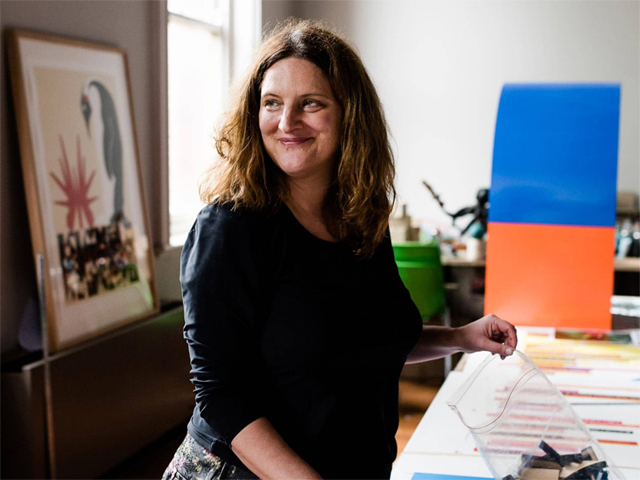Emily Floyd: Anti-Totalitarian Vectors

Anna Schwartz Gallery is delighted to present Anti-totalitarian Vectors, a new body of work by Australian artist Emily Floyd from 13 July – 17 August. Floyd, who was born into a family of toymakers, works in sculpture, printmaking and public installation. She is renowned for her text-based sculptures and pedagogically inspired works that combine a strong focus on visual qualities with an interest in the legacies of modernism.
Anti-totalitarian Vectors is a series of sculptures that blend childhood space with political philosophy, activating the urgent legacy of twentieth century anti-totalitarian struggle. The exhibition is conceived as a compendium of typographic artefacts and objects which together form a 'library and garden of medicinal herbs', dedicated to the Hungarian philosopher and core member of The Budapest School, Ágnes Heller.
Through close attention to Heller's texts, the exhibition comprises philosophical motifs drawn from A Philosophy of History in Fragments. It will include a large-scale, 1.5m high Owl of Minerva sculpture cast in aluminium, a family of cast bronze Umlauts, and Monoliths: free-standing, aluminium forms over 2.5m in height that feature abstractions of original book covers by The Budapest School.
The exhibition will be composed of four elements:
● The Owl of Minerva – cast as a Snowy Owl holding a lantern – marks the urgency of historical understanding and anti-totalitarian struggle. The Owl of Minerva is an emblem of continental philosophy – in Greek and Roman mythology she is a symbol of knowledge and insight, the familiar and non-human companion of Athena or Minerva, goddess of wisdom. For Heller, after Hegel, "Philosophy is the owl of Minerva; it casts a retrospective glance. Speculative thinking is this retrospective glance." The Owl of Minerva spreads its wings only with the falling of the dusk – meaning that philosophy comes to understand a historical condition just as it passes away.
● Umlauts - An umlaut (/ oo m-lout /) is used over a vowel, as in Hungarian or German, to indicate a different vowel quality, usually fronting or rounding. The sculptural Umlauts envision speculative fragments of a Hungarian Letterpress, cast in bronze with black patina, for typesetting a library of The Budapest School – a philosophical circle whose core group found exile in Australia between 1977 – 1986. Heller's theory is evoked to consider how contemporary forces bring new objects into the world.
● Monoliths - A recurrent motif in Floyd's work is the library. A series of structured, architectural edifices inscribed with dynamic, geometric compositions hold space and the objects contained within, creating a garden from ideas. Six free-standing, architecturally-scaled, aluminium sculptures or book forms feature abstractions of original book covers of György Lukacs, Heller and The Budapest School, including Lukacs' Tactics and Ethics (New Left Books, 1972), Heller's The Theory of Need in Marx, the Hungarian journal Tiszatáj and Australian journal Thesis Eleven.
● Anti-totalitarian Vectors - Floyd has produced a screen print poster portfolio based on journal and book covers of texts by Lukács, Heller and The Budapest School. Floyd's extended title-page for the edition speculates on the limits and possibilities of the archival turn in contemporary art.
The exhibition is open to the public from 13 July until 17 August with a public, walking conversation between Emily Floyd and Julie Ewington, scheduled to take place in the gallery on Saturday 3 August 2019.
EMILY FLOYD
'ANTI-TOTALITARIAN VECTORS'
13 JULY– 17 AUGUST 2019
ANNA SCHWARTZ GALLERY
185 FLINDERS LANE
MELBOURNE
MORE





